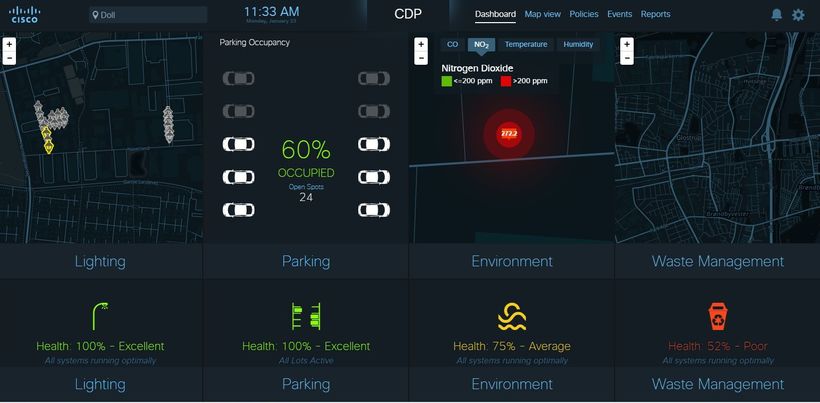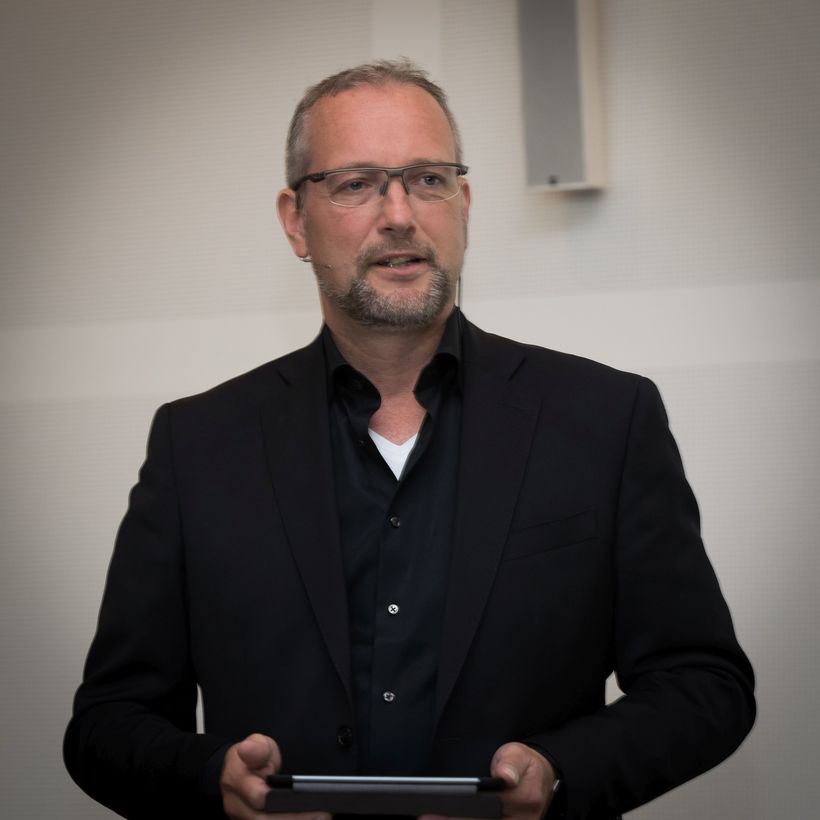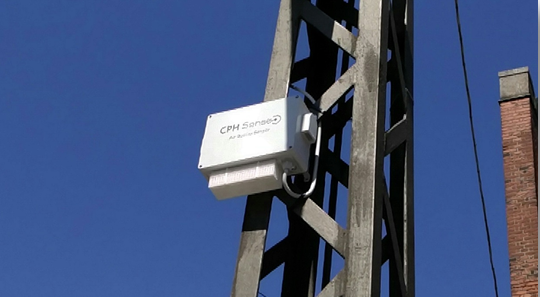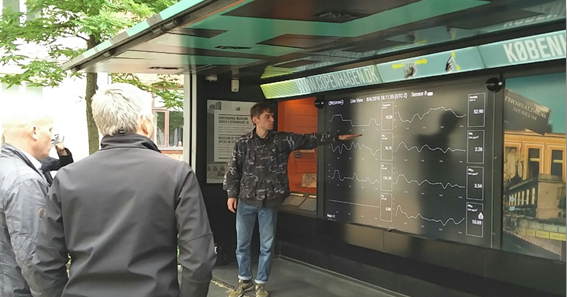[Prologue: Bas Boorsma, a historian by training, is by inclination an apostle of network connectivity. Those who will control the Internet of Things that he’s developing will have tremendous power over the structures within which people learn, get health care, play, and get energy, as well as receive mundane messages. Boorsma is excited by the opportunities to put all this power to work for humanity and climate protection. “My academic guess,” he says, “is that there is no way we can achieve our climate goals without the Internet of Things.”]
Bas Boorsma
Copenhagen, Denmark— Copenhagen has the most ambitious plan to become carbon-neutral of any Western capital city. It aims to accomplish this momentous goal just eight years from now. One new weapon in its campaign is digitalization
Digitization is the conversion of any analog information, for example text, pictures, or sound, into a digital form, consisting of a code of 0’s and 1’s that can be processed by a computer.
According to Bas Boorsma, the more relevant process for Copenhagen is digitalization.
Digitalization, Boorsma explains, refers to how our social and economic life, as well as the core processes of our organizations, are influenced by network design, digital technologies, and the organizational structures, values, rules, and expectations they induce.
Boorsma thinks that digitalization could save Copenhagen money big-time and accelerate its transition to clean energy while creating thousands of new jobs.
Using the New Vocabulary
Copenhagen city leaders also think digitalization can be a boon to Copenhagen. With appropriate software and analytical capabilities, “smart city technology” will ultimately allow the city to monitor crucial aspects of the urban environment and analyze data on urban conditions.
The system will be able to monitor urban traffic and transport systems, street lighting, parking availability, traffic flow, air quality, and soil conditions, as well as the performance of transit, waste management, and security systems.
A digital dashboard that is capable of displaying readouts created by CISCO’s Smart+Connected Digital Platform for Cities can now show the status of street lights, parking availability, and air quality for a part of western Copenhagen. Over time, digitalization is likely to make a growing contribution to the city’s efforts to reduce its greenhouse gas emissions.
Along the way to its goal of carbon-neutrality by 2025, Copenhagen is also serving as an incubator for companies working on smart city technology, an enterprise that is projected to be worth $400 billion a year globally by 2020.
A desire for green growth is a major driver of this activity. Technology and big data are the growth enablers. Digitalization often leads to new business and service delivery models. But first, data must be collected, processed, and utilized.
Street digitalization, for example, is the process of digitalizing and converging data on a brace of outdoor processes and activities. These can include individual or transport mobility, parking, street lighting, waste management, air quality, and even public security.
Once they are interpreted by computer algorithms, this data could, for example, determine an optimal travel plan, find a parking place, or save the city energy and resources in other ways by operating lighting and water systems more efficiently.
Through digitalization, water, waste, energy, and communications systems become intelligent due to sensors and artificial intelligence and can talk to each other in the service of efficiency and energy savings. Or in the service of emissions reduction and climate protection.
Within the realm of digitalization, Bas Boorsma’s mandate is to develop relevant applications of the Internet of Things (IoT) for Copenhagen. For the record, the Internet of Things is the system of interconnections between objects and the Internet.

Bas Boorsma
The Internet of Things in Context
Starting about 2007, more things began to be connected to the Internet than people. The growth in objects coming on line has been exponential ever since. “Digitalization is going to have an impact on society 5-10 times as large as the internet today,” Boorsma says. That means this networking revolution is just beginning.
A hundred thousand objects to a million are getting connected to the network globally every hour now, Boorsma says. The Internet of Things is thus no longer a gadget.
“This is a fundamental cornerstone of our society. It now ties into our health care systems, our physical security, our electricity grids, and our sewage.”
Because these systems and infrastructure are so critical, Boorsma regards the Internet as essential infrastructure for society today. It is opening up vast opportunities for businesses, individuals, and countries in logistics, transport, environmental monitoring, and other domains.
The partnership framework under which CISCO analyzes potential innovations for Copenhagen is a public-private partnership known as Streetlab. Its mandate spans outdoor lighting, city WiFi, smart parking, security, location-based services, air pollution analytics, “smart waste,” and use of sensors to monitor mobility, soil changes, and water quality.
Of all the things that could potentially be interconnected—whether it’s our jackets, a chair, or a hospital exit—only one percent has been connected so far, Boorsma says. But by 2020, some 30 billion new objects are expected to be hooked up.
Boorsma forecasts that in just three years, three-quarters of all enterprises will have to be fully digitized. More ominously, he expects that most will fail at it. Thus, based on studies by CISCO’s economic research arm, he believes that in less than 10 years, more than 40 percent of all of today’s enterprises won’t even exist anymore, because of digitalization.
For now, however, Boorsma, a one-time advisor to UN Peacekeeping forces in Cambodia, is focusing on the opportunities rather than the disruption.

Bas Boorsma
Lighthouse Copenhagen
Currently Boorsma leads CISCO’s city engagement team in Northern Europe and supports the company’s portfolio of global smart city “lighthouse” projects. In this capacity, he helps cities implement Internet of Thing strategies that impact the efficiency of their energy, water, waste management, transport, health, and public safety systems.
“The reason that we wanted to work with the city of Copenhagen,” Boorsma said, “is that Copenhagen is so focused on its climate agenda. We believe and understand that the Internet of Things is a critical ingredient to the resilient and sustainable community of tomorrow.”
Copenhagen is an exemplar, seeking to be the world’s most sustainable city and streaking ahead of the world toward carbon-neutrality, which it plans to attain in 2025.
Depending on the particular IoT technology involved, Boorsma and his CISCO team are typically somewhere on the continuum between proof-of-concept and fully proven, scalable, replicable products along with guaranteed, deliverable solutions. Meanwhile, they are trying to find out pragmatically what the costs, risks, and benefits are for cities like Copenhagen.
A Living Lab
Since signing an MOU with the Mayor of Copenhagen in 2014, CISCO has delivered on digital air quality sensing, mobility monitoring, smart lighting strategies, smart waste management, soil water saturation sensing, and smart parking.
Smart parking, for example, allows sensors to detect whether cars are parked at particular spots, providing real time data on space availability. Because at any time 30 percent of inner city traffic is looking for a parking spot, according to Boorsma, streamlining parking saves money, energy and reduces the city’s carbon footprint.
Another mature area in which CISCO is working in Copenhagen is outdoor lighting.
Some 25 outdoor lighting vendors are demonstrating their lighting solutions at The Denmark Outdoor Light Lab, which has evolved into a large Urban Services Laboratory (USL).
USL now features smart waste solutions, air quality sensing (real time measurements of fine dust particles, NOX, CO2, etc.), noise detection, water pump management (to monitor and control pumps remotely), and multiple smart parking solutions.

Bas Boorsma
CISCO crunched the numbers in Copenhagen to determine where the Internet of Things had the potential to produce the greatest economic return and concluded that improvements in traffic flow would deliver very large economic gains to the city.
Here is an example of how CISCO’s network technologies and data analytics can generate new business and service delivery models to modernize mobility in Copenhagen.
Suppose there is a rock concert or major sports event in town. The convergence of data from parking sensors with data on weather and traffic congestion, Boorsma says, then could be used to guide traffic to areas where parking would be optimal and dynamically priced lower for the duration of the event.
CISCO is working on this technology by deploying its Smart+Connected Digital Platform for cities in parts of Copenhagen where street data from sensors mounted on lamp posts are converged, visualized, analyzed, and, in the future, will be used for management decision making.
CISCO has a longer track record in Barcelona than in Copenhagen. Over a five-to-six year period, it put a comprehensive street digitalization program in place in Barcelona. The program included street automation, smart bus stops, smart lighting, smart parking, smart buildings, and smart campuses, all built on the back of new broadband deployment. When CISCO did the math, they found they had created about 5,000 new jobs in the process.
Crossing Boundaries
To gain maximum value from the service that CISCO offers, a city must have leadership that thinks across departments. “This typically starts with the Mayor,” Boorsma said. The city has to think about how to orchestrate the work of its Internet of Things partners, namely the utilities, service providers, information technology companies, construction companies, and architects.
If any are left out, Boorsma said, “we’re missing the party. . . . We need innovations at all levels.” The idea is not to just narrowly deploy digitalization in one field or in a siloed system. Successful digitalization operates horizontally across departments and sectors to reach many societal stakeholders. “Success,” Boorsma says, “requires the involvement of all.”
By way of comparison, Boorsma points out, “The mayor does not just talk about health care, education, or outdoor light, or energy grids. He talks about the total well-being of his city,” now and in the future.
Getting Across the Finish Line
We can achieve the first 50 percent of a metropolis’s climate goals using traditional means he contends, for example, by replacing coal plants with renewable energy and by insulating buildings.
“But then,” he says, “you’re going to get stuck, and it’s very difficult to achieve that final 50 percent.” To get the last 50 percent, Boorsma argues that we have to create a paradigm shift by going from the older, centralized ways of self-organization, including the old central station coal plant, and replace them with “a totally distributed pattern for human conduct.”
This vision not only spans energy production to distribution, but extends to the way we look at our work, transport, and security. “That has huge implications for how we can green our society,” said Boorsma.
“You’re going to have to go through and embrace this paradigm shift in order to have this greening effect. This goes deep into changing a culture and to areas of our lives that are offline.” he maintains
Boorsma cites the example of the energy savings possible when the rigidity of the centrally controlled traffic light is replaced by the roundabout at which each driver makes a decision whether to stop or go in a decentralized manner. Drivers save time and fuel, and gain autonomy. Society saves energy, resources, and gains efficiency.
Smart Lighting
Another example Boorsma likes is the boost in efficiency to an outdoor lighting system that occurs after LED lights have been added and the system then also gets smart on-off switching and the ability to dim itself, all based on the movement of people and drivers in the street.
“On highways you can do boxed light,” Boorsma said. “That’s now proven technology. Let’s say it’s 4 am and you’re a driver on the highway. In front of you, lights go up. Behind you, lights go down. As a driver, you have a constant light experience, because you’re always in this box, but the overall power consumption reduced is remarkable.”
Whereas an LED street light can save 40-60 percent of the power once needed by an old-fashioned outdoor light, the addition of smart switching can boost total savings all the way to 80-90 percent. This technology can be applied to improve traffic light efficiency, too.
Smart Waste
In several cities, Boorsma’s team has created systems of sensors in communal waste bins to measure and communicate how full they are. This enables a garbage truck to know in advance which bins need to be emptied and which can be collected at a later time.
“The garbage truck no longer needs to stop at each bin, only to find many of them half-full. Sensors can also be deployed that indicate the type of waste in the bin.
“If you do this structurally within a city, you’re going to reduce the overall pick-up time and the amount of gasoline spent on the trucks,” Boorsma said. That’s the attraction of the integrated Internet of Everything model.
“It’s Lego-like architecture allows all sorts of different systems to plug in and then talk to the entire network through the services of a very simple, inexpensive sensor that picks up and relays real-time information.
By contrast, Boorsma said, “If you were to buy SIM cards for every sensor in every waste bin and had to buy the connectivity for that one use case, it would be so darn expensive it wouldn’t fly. In fact, the City of Copenhagen tried this many years ago and shut it down because it was too expensive.”
Other Urban Applications
The most cost-effective uses for the digitalization in cities today are in all things related to mobility, lighting, and the smart energy grid. “Once you build that, our next level of advice is make sure you get organized within the city,” says Boorsma. Light poles, for example, are put to use as charging points and mounts for sensors able to detect traffic congestion, potholes, water, and threats. Here the pitfall is continued loss of privacy as monitoring becomes even more ubiquitous.
Not only can the IoT optimize a city’s efficiency in every possible arena, but it can be used to network cities together to improve their joint efficiency. In a regional transit systems, for example, an intelligent system that understood how the transportation system and traffic in one city affect another could optimize the system and promote its overall efficiency.
Thus when CISCO signed its MOU with Copenhagen for its IoE strategy, it did it for the greater Copenhagen region. “Everyone understands that as we build mobility-related solutions,” Boorsma said, “this has implications for the entire capital region.”

Bas Boorsma
Open Architecture
To make all these systems maximally efficient, they require complete integration with each other via a common architecture. Boorsma envisions something metaphorically akin to a “Lego base plate” into which multiple solutions, related, for example, to traffic, water supply waste management, air quality, public security, and energy, all would be plugged.
The advantage of this, says Boorsma, is that once you have this open architecture, “it becomes very, very easy to pull in additional use cases” that would otherwise be too expensive to connect. The potential convergence of numerous applications through the same broadband system makes the business model so compelling.
Some critics of converging multiple systems in one architecture fear that because everything is made interdependent, the risk of a multiple system failure to dwarf all prior system failures cannot be zero. In addition, with the open-industry standardized system that CISCO advocates, “everyone can look in,” in Boorsma’s words.
Boorsma contends, however, that open industry standards help engineers build secure protocols and systems. “CISCO excels at building architectures that are seamless and secure, with a lot of ´intelligence´ embedded at the edge of networks,” Boorsma says. “Such distributed designs help overcome the potential vulnerabilities that stem from interdependency.”
Conclusion
The quest if not impatience for the benefits that the Internet of Things can ultimately provide has prompted Copenhagen to join forces with Antwerp and Helsinki in a multimillion dollar, EU-funded competition.
Known as Select4Cities (www.select4cities.ed), the goal is to stimulate the design, research and development of a data-driven, Internet of Everything platform for European cities. Its function would be to enable the large-scale co-creation, testing and validation of Internet of Everything urban apps and services.
The Internet of Everything would not simply be the Internet of Things on steroids. The Internet of Everything would be more intelligent and would include vast amounts of big data and processes. At some time in the future, real-time biometric data from masses of people might also be connected to the network.
One can spin that into all kinds of dystopian fantasies. Big Brother might not only be watching our every move, but he might also know our first and last names, where we live, and the kind of coffee we buy at Starbucks.
More mundanely, sponsors of Select4Cities hope the contest will help overcome barriers that have held back Internet of Everything progress. These barriers have included a lack of common standards, a fragmented marketplace, and need for a platform upon which to test and introduce new IoE solutions.
____________________________________
John J. Berger, PhD. (www.johnjberger.com) is an energy and environmental policy specialist who has produced ten books on climate, energy, and natural resource topics. He is the author of Climate Peril: The Intelligent Reader’s Guide to the Climate Crisis, and Climate Myths: The Campaign Against Climate Science, and is at work on a new book about climate solutions.
Follow John J. Berger on Twitter: www.twitter.com/johnjberger